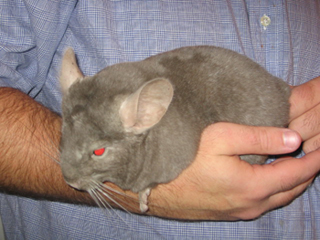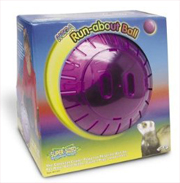So You Have a New Chinchilla!You've got all the supplies and now you're wondering how to handle your new chinchilla.
Chinchillas are incredibly curious animals, but you need to let them know you are not a predator. Talk to your chinchilla and nuzzle with them regularly. Now for playtime! You need to have a "chinproofed" room or area. Usually a bathroom works well because there are few external wires (if any) and a door, but try to use some area rugs so your chinchilla doesn't slip around too much. Remember that chinchillas will chew anything, so whatever area you choose make sure sure that electrical cords are covered or removed. Also make sure there are no hiding spots that you can not access should you have to. Chinchillas will nibble on baseboards, wallpaper, cabinets, carpet, sofas... so have some toys (wood, cardboard) out that they can interact with. Make sure you can supervise them the entire time they are out, because they will find things and areas you would never predict. After your new chinchilla explores the area you will get to see their playful side, with more chewing and "popcorning" (the sprinting and bouncing off of things). Eventually you have to catch your chinchilla. Using a catch phrase (to train your chinchilla) such as "time to go back home," you'll have to corner and scoop up your chinchilla. Unless there are things to hide under this is not as difficult as it sounds, and you'll improve with practice. Just be patient! Scoop and grab at the base of the tail with your thumb and forefinger (this doesn't hurt them) and support their body with your other hand. You can go through this process several times so your chinchilla starts to learn the routine. Chinchillas are largely nocturnal, but they are most active at dawn and dusk. Let them get used to a normal environment, with relative quiet during the day. In the evening they'll be ready for food and play.
Head here if you need more information on training your new chinchilla. Don't have one yet? Here's what to look for in a pet chinchilla. Here's some general information about chinchillas. What supplies do I need?
Do NOT purchase the plastic exercise ball (this is a common mistake for the new chinchilla owner)! Putting a chinchilla in an mostly enclosed ball for any period of time will overheat and possibly kill them. Later you may upgrade to a wheel (especially if your chinchilla doesn't get out of the cage very much). Check here for more information on particular supplies. As chinchilla are rodents they need to chew constantly to keep their their filed. Make sure you give them a safe wood, like untreated pine. The room temperature should never exceed the mid 70's, so an air conditioner may be essential depending on where you live in where the pet chinchilla is located in the house. No drafts or direct sunlight, either - they can be dangerous! |
Subscribe to our newsletter to get the latest updates and news on contests and sales!
|
|
|
| Homepage |Supplies |Chinchilla Books | |
||
|
Copyright© Chinchilla Source 2010. | ||
 Well, unless you got a really sweet one, or have done some
Well, unless you got a really sweet one, or have done some  To get started you need a
To get started you need a 
